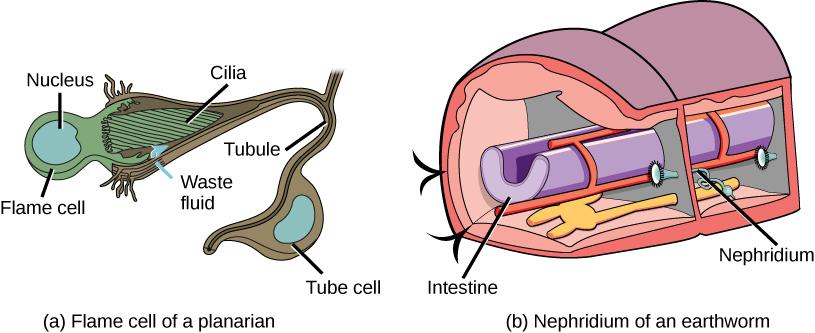Learning Objectives
Learning Objectives
In this section, you will explore the following questions:
- How do vacuoles, present in microorganisms, work to excrete waste?
- How do flame cells and nephridia in worms perform excretory functions and maintain osmotic balance?
- How do insects use Malpighian tubules to excrete wastes and maintain osmotic balance?
Connection for AP® Courses
Connection for AP® Courses
The information in this section is not within the scope for AP® other than to appreciate that other organisms, including microorganisms and invertebrate animals, use more primitive and simple mechanisms to get rid of metabolic waste and maintain osmotic balance. For example, contractile vacuoles are common in microorganisms; flame cells and nephridia in certain species and worms, and Malpighian tubules in insects are other examples of excretory systems. Osmoregulation is vital for all organisms to maintain homeostasis.
Information presented and examples highlighted in this section are not within the scope for AP® and do not align to the Curriculum Framework.
Contractile Vacuoles in Microorganisms
Contractile Vacuoles in Microorganisms
The most fundamental feature of life is the presence of a cell. In other words, a cell is the simplest functional unit of a life. Bacteria are unicellular, prokaryotic organisms that have some of the least complex life processes in place; however, prokaryotes such as bacteria do not contain membrane-bound vacuoles. The cells of microorganisms like bacteria, protozoa, and fungi are bound by cell membranes and use them to interact with the environment. Some cells, including some leucocytes in humans, are able to engulf food by endocytosis—the formation of vesicles by involution of the cell membrane within the cells. The same vesicles are able to interact and exchange metabolites with the intracellular environment. In some unicellular eukaryotic organisms such as the amoeba, shown in Figure 32.5, cellular wastes and excess water are excreted by exocytosis, when the contractile vacuoles merge with the cell membrane and expel wastes into the environment. Contractile vacuoles (CV) should not be confused with vacuoles, which store food or water.
Flame Cells of Planaria and Nephridia of Worms
Flame Cells of Planaria and Nephridia of Worms
As multi-cellular systems evolved to have organ systems that divided the metabolic needs of the body, individual organs evolved to perform the excretory function. Planaria are flatworms that live in fresh water. Their excretory system consists of two tubules connected to a highly branched duct system. The cells in the tubules are called flame cells (or protonephridia) because they have a cluster of cilia that looks like a flickering flame when viewed under the microscope, as illustrated in Figure 32.6a. The cilia propel waste matter down the tubules and out of the body through excretory pores that open on the body surface; cilia also draw water from the interstitial fluid, allowing for filtration. Any valuable metabolites are recovered by reabsorption. Flame cells are found in flatworms, including parasitic tapeworms and free-living planaria. They also maintain the organism’s osmotic balance.
Earthworms (annelids) have slightly more evolved excretory structures called nephridia, illustrated in Figure 32.6b. A pair of nephridia is present on each segment of the earthworm. They are similar to flame cells in that they have a tubule with cilia. Excretion occurs through a pore called the nephridiopore. They are more evolved than the flame cells in that they have a system for tubular reabsorption by a capillary network before excretion.
Malpighian Tubules of Insects
Malpighian Tubules of Insects
Malpighian tubules are found lining the gut of some species of arthropods, such as the bee illustrated in Figure 32.7. They are usually found in pairs and the number of tubules varies with the species of insect. Malpighian tubules are convoluted, which increases their surface area, and they are lined with microvilli for reabsorption and maintenance of osmotic balance. Malpighian tubules work cooperatively with specialized glands in the wall of the rectum. Body fluids are not filtered as in the case of nephridia; urine is produced by tubular secretion mechanisms by the cells lining the Malpighian tubules that are bathed in hemolymph (a mixture of blood and interstitial fluid that is found in insects and other arthropods as well as most mollusks). Metabolic wastes like uric acid freely diffuse into the tubules. There are exchange pumps lining the tubules, which actively transport H+ ions into the cell and K+ or Na+ ions out; water passively follows to form urine. The secretion of ions alters the osmotic pressure which draws water, electrolytes, and nitrogenous waste (uric acid) into the tubules. Water and electrolytes are reabsorbed when these organisms are faced with low-water environments, and uric acid is excreted as a thick paste or powder. Not dissolving wastes in water helps these organisms to conserve water; this is especially important for life in dry environments.
Link to Learning
Visit this site to see a dissected cockroach, including a close-up look at its Malpighian tubules.
- Malpighian tubules are the tubules within a nephron in humans.
- Malpighian tubules are the opening of the digestive sac in box jellyfish.
- Malpighian tubules are organs that filter waste from hemolymph in cockroaches.
- Malpighian tubules are tiny, bulb-shaped organs that open to an excretory pore in leeches.
Disclaimer
This section may include links to websites that contain links to articles on unrelated topics. See the preface for more information.




